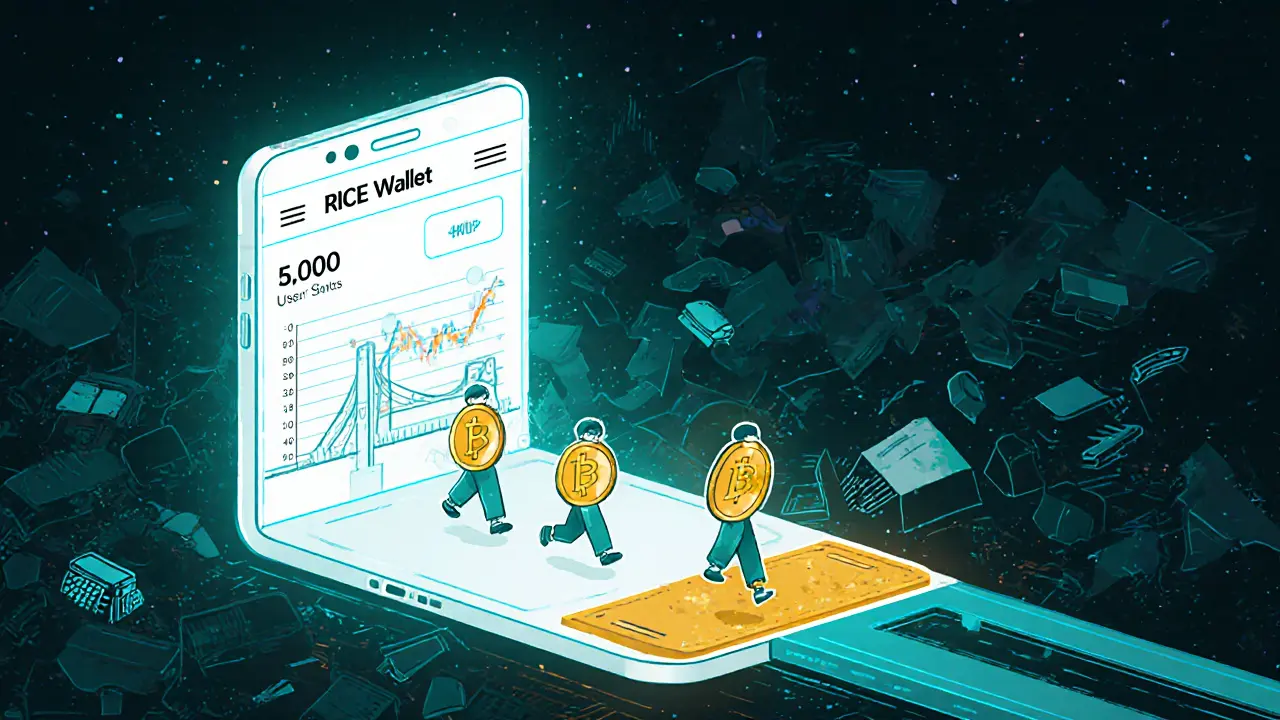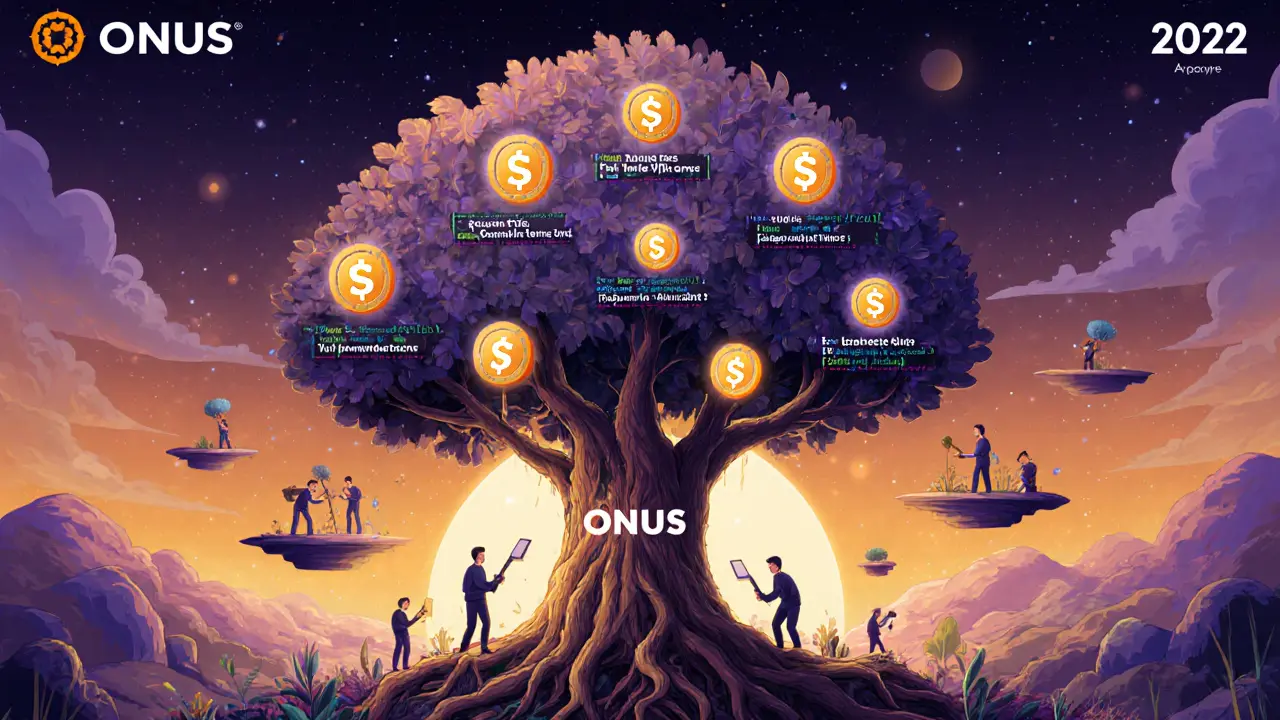
Airdrop Probability Calculator
How This Airdrop Worked
6.2 million participants entered the ONUS x CoinMarketCap airdrop from March to March 20, 2022. Only 5,000 winners claimed 15 ONUS tokens each.
Key insight: The ONUS airdrop succeeded because it forced winners to use RICE Wallet, turning a giveaway into a user acquisition engine. This created long-term ecosystem value.
Probability of Winning
0.08%
Value of Winning
$10.43
Why This Airdrop Worked
RICE Wallet Requirement
Forced users into the ecosystem, creating long-term adoption
Token Utility
Used for trading fees, VIP tiers, and asset conversions
No Wallet Requirement
Most airdrops become worthless without ecosystem integration
The ONUS x CoinMarketCap airdrop wasn’t just another free token giveaway. It was a carefully engineered campaign that pulled in over 6.2 million participants in just 20 days - all for a chance to win a share of 75,000 ONUS tokens. That’s less than a 0.1% chance of winning. But why did so many people show up? And what happened after the tokens landed in wallets?
How the Airdrop Actually Worked
The ONUS airdrop ran from early March to March 20, 2022. To enter, you had to complete a few simple steps through CoinMarketCap’s platform. The first step was adding ONUS to your watchlist - a basic move, but one that helped CoinMarketCap track interest in the token. After that, participants had to verify their accounts and likely engage with ONUS on social media (Twitter, Telegram, etc.). The exact steps weren’t fully public, but the process was designed to be easy enough for newcomers while filtering out bots. Winners were chosen randomly from the 6.2 million entries. Only 5,000 people won. Each winner received 15 ONUS tokens - 75,000 total divided evenly. At the time, that was worth about $10 per person. Not life-changing money, but enough to get people curious. Here’s the catch: you couldn’t claim your tokens just anywhere. Winners had to provide a Binance Smart Chain wallet address through the RICE Wallet app. No exceptions. If you didn’t download RICE Wallet and link your address before April 1, 2022, you lost your reward. That wasn’t an accident. ONUS didn’t just want to give away tokens - they wanted to grow their own ecosystem.Why RICE Wallet Was the Key
Most airdrops send tokens to any Ethereum or BSC wallet. ONUS didn’t do that. They forced winners to use RICE Wallet, their own mobile app. Why? Because they knew free tokens are useless if people don’t use them. By making RICE Wallet the only way to claim, they turned a marketing campaign into a user acquisition engine. RICE Wallet wasn’t just a storage tool. It was built for the Make Money Online (MMO) ecosystem - a platform where users could earn tokens by completing tasks, trading, or joining future airdrops. Suddenly, 5,000 new users were inside the ONUS ecosystem. Many of them didn’t know what ONUS was before the airdrop. Now they had tokens, an app, and a reason to stick around. This move was smart. It turned a one-time giveaway into a long-term user funnel. By 2025, RICE Wallet had become one of the most-used mobile wallets for ONUS holders, thanks in large part to this campaign.
What Happened to ONUS After the Airdrop
The airdrop wasn’t the end - it was the beginning. In the years that followed, ONUS evolved from a promotional token into a working blockchain platform. By July 2025, its two-year token vesting schedule ended. That meant more tokens entered circulation, boosting liquidity and trading volume. Trading volume for ONUS hit over $1.26 million in a single day in September 2025. The price hovered around $0.6956 - up from less than $0.01 during the airdrop. That’s a 70x increase. Not all of that growth came from the airdrop, but the campaign laid the foundation. It gave ONUS credibility. It showed the market that a relatively unknown token could attract massive attention through smart partnerships. In August 2025, ONUS made major changes to its futures trading platform. VIP tiers were lowered - you now needed only 2,500 ONUS tokens (down from 5,000) to reach VIP 3 status. Makers paid as little as 0.01% in fees. These changes made ONUS more attractive to active traders, not just speculators. Even more telling: in September 2025, ONUS automatically converted users’ holdings of three delisted tokens - BakeryToken, Hifi Finance, and Self Chain - into ONUS if they held over 100 USDT worth. That wasn’t a voluntary swap. It was forced. And it created instant demand. Thousands of users who held those tokens suddenly had to buy ONUS to avoid losing value. That kind of utility doesn’t happen by accident.Why This Airdrop Still Matters Today
CoinMarketCap has since launched its own Launchpad platform, using advanced wallet analysis to block spam accounts. That’s a direct response to campaigns like ONUS’s - where bots tried to game the system. The ONUS campaign proved that even with millions of participants, a well-structured airdrop could still work. It also showed that airdrops aren’t just about free tokens. They’re about building ecosystems. ONUS didn’t just hand out tokens - they handed out access. Access to RICE Wallet. Access to trading. Access to a growing network of users. Compare that to other airdrops from 2022. Many gave away tokens with no real use case. Those tokens are now worthless. ONUS tokens? They’re still actively traded, staked, and used in fee discounts. That’s the difference between a flash in the pan and a real project.
What You Can Learn from This Airdrop
If you’re thinking about joining a future airdrop, here’s what you should look for:- Is the project building real infrastructure? (RICE Wallet, trading fees, token utility)
- Are they forcing winners to use their own app? (That’s a sign they care about long-term adoption)
- Has the token gained real trading volume since the airdrop?
- Are there ongoing updates - fee changes, conversions, new features?
ONUS Today: More Than Just an Airdrop
Today, ONUS isn’t just a token you got from a giveaway. It’s part of a functioning blockchain built for DeFi and cross-chain transfers. It’s used in trading platforms. It’s used to reduce fees. It’s used to convert other assets. It’s not just a speculative asset - it’s a utility token with real mechanics behind it. The airdrop was the spark. The years of updates, liquidity releases, and ecosystem growth are what kept the fire burning. If you’re looking at ONUS now, don’t just see the price. See the history. See the 6.2 million people who showed up. See the 5,000 who claimed their tokens. See the 2,500 ONUS threshold for VIP trading. See the forced conversions. See the wallet that grew from a claim portal into a full trading app. That’s what makes this airdrop different. It didn’t end when the tokens were sent. It just began.Was the ONUS x CoinMarketCap airdrop legitimate?
Yes, it was legitimate. The campaign was run directly through CoinMarketCap’s official platform, with clear rules and a public end date. Winners were selected randomly from over 6 million participants, and all rewards were distributed through RICE Wallet within seven working days after the campaign ended. CoinMarketCap’s reputation as a trusted crypto data source added credibility to the campaign.
How many people won the ONUS airdrop?
Exactly 5,000 participants won the ONUS airdrop. With 75,000 ONUS tokens total to distribute, each winner received 15 ONUS tokens. Given that over 6.2 million people entered, the odds of winning were roughly 0.08% - making it one of the most competitive airdrops of its time.
Why did winners need to use RICE Wallet?
ONUS required winners to use RICE Wallet to ensure long-term adoption of their own platform. Unlike most airdrops that send tokens to any wallet, ONUS used the giveaway to onboard users into their ecosystem. RICE Wallet wasn’t just a storage tool - it was the gateway to trading, earning, and future airdrops. This strategy turned a one-time promotion into a user acquisition engine.
Can I still claim ONUS tokens from the 2022 airdrop?
No, the claim period ended on April 1, 2022. If you didn’t provide your RICE Wallet address before that date, you missed out. The airdrop was a one-time campaign, and no extensions or retroactive claims were offered. However, you can still buy ONUS tokens on supported exchanges or earn them through current platform activities.
Is ONUS still active in 2025?
Yes, ONUS is very active in 2025. The token completed its two-year vesting schedule in July 2025, increasing liquidity. Trading volume regularly exceeds $1.2 million per day, and the price sits around $0.6956. Recent updates include reduced futures trading fees and a halved VIP requirement (now 2,500 ONUS tokens). ONUS also automatically converts delisted tokens into ONUS for users holding over 100 USDT, creating ongoing demand.
What’s the difference between ONUS and other airdrop tokens?
Most airdrop tokens have no real use after distribution - they’re bought and sold, then forgotten. ONUS built real utility: it’s used to reduce trading fees, powers its own wallet (RICE), and is used to convert other tokens. It’s not just a speculative asset. Its ecosystem keeps growing, which is why it’s still trading strongly years after the airdrop ended.


Comments
Alex Horville
This airdrop was pure strategy, not luck. ONUS didn’t just hand out tokens-they handed out a gateway. Most projects give you free garbage and vanish. ONUS made you use their app, stick around, and eventually trade. That’s not marketing. That’s warfare.
And the forced token conversions? Genius. People who held BakeryToken or Self Chain had no choice but to buy ONUS. That’s not a giveaway-it’s a takeover.
Stop chasing airdrops that don’t lock you into a platform. Look for the ones that force you to stay. That’s where real value is built.
Marianne Sivertsen
I remember signing up for this just because I thought ‘free crypto’ meant free money. Turns out, I got 15 tokens and a weird app I didn’t understand. But honestly? I stayed. RICE Wallet turned out to be way more useful than I expected. I even started doing small tasks on it to earn more.
It wasn’t life-changing, but it was the first time a crypto project actually made me feel like I belonged somewhere. Not just a wallet address. A community.
Most airdrops feel like spam. This one felt like an invitation.
Shruti rana Rana
OMG!!! 🤯 This is the MOST SMARTEST airdrop I’ve ever seen in my entire crypto journey!! 🇮🇳🇺🇸
ONUS didn’t just give tokens-they gave a whole NEW WORLD!! RICE Wallet became my second home!! 💎🔥
And when they converted those dead tokens into ONUS?? I cried!! Not because I made money-but because someone finally understood that crypto isn’t just speculation-it’s ECO-SYSTEM!! 🌍💸
India needs more projects like this!! Not fake airdrops with 10M bots-REAL vision!! 🙏✨
Stephanie Alya
Wow, so ONUS just tricked 6 million people into downloading their app and now they’re calling it ‘ecosystem growth’? Classic.
‘Oh, you didn’t claim your 15 tokens? Too bad!’
Meanwhile, the 5,000 who did? Now they’re stuck in a wallet that pushes them to trade, earn, and buy more tokens just to stay ‘active.’
It’s not a community. It’s a pyramid with a fancy UI.
And yes, the price went up. But so did the number of people who bought ONUS just to avoid losing their BakeryToken holdings. That’s not utility-that’s coercion.
Still, I’ll give them this: they did it better than 99% of the garbage out there.
olufunmi ajibade
Let me tell you something-most airdrops are scams disguised as generosity. But ONUS? They didn’t ask for your private key. They didn’t ask for your seed phrase. They just asked you to use their app.
And guess what? That’s the most honest thing any crypto project has done in years.
They knew people would ghost them after claiming. So they made the app useful enough to keep you. That’s not manipulation-that’s respect.
I’ve seen projects promise the moon and deliver nothing. ONUS delivered a tool. And tools last longer than hype.
Manish Gupta
Why did they pick RICE Wallet? Because they knew most people would just dump the tokens on exchange. But if you force them to use your app, you get data, activity, and retention.
It’s not magic. It’s behavioral economics.
Also, the forced conversion of delisted tokens? That’s cold. But effective. People don’t like losing value. So they buy ONUS. Instant demand.
Most airdrops are marketing. This one was a business model.
Gabrielle Loeser
The structure of this airdrop reflects a sophisticated understanding of user onboarding in decentralized ecosystems. The requirement to use RICE Wallet ensured that participants were not merely speculative actors but potential long-term stakeholders.
The deliberate limitation of claim windows and the integration of utility-based incentives-such as fee reductions and token conversions-demonstrate a departure from the traditional ‘free token’ paradigm.
This model should serve as a benchmark for future token launches seeking sustainable adoption rather than transient hype.
Cyndy Mcquiston
6.2 million entries and only 5k winners? That’s not a giveaway. That’s a lottery designed to make you feel like you almost won.
They didn’t want users. They wanted attention.
Now they’re calling it ‘ecosystem growth’ like it’s noble. It’s just clever manipulation wrapped in blockchain jargon.
Still… I got my 15 tokens. So I’m not mad. Just woke up.
Abby Gonzales Hoffman
Let me tell you something real-this airdrop didn’t just give you tokens. It gave you a reason to care.
I thought I was just signing up for free crypto. Turns out, I found a wallet that actually works. I started trading. I lowered my fees. I even earned more tokens just by using the app.
Most airdrops are dead by week 2. ONUS? It’s still alive. And growing.
If you’re still chasing free tokens without asking ‘what’s next?’ you’re playing the wrong game.
This isn’t luck. It’s leverage. And you can too.
ashish ramani
The RICE Wallet requirement was the smartest part. Most projects treat users like numbers. ONUS treated them like potential users. That’s rare.
Also, the forced conversions were aggressive but fair. If you held dead tokens, you had to move. No hand-holding. No pity.
It worked. I respect that.
Natasha Nelson
Okay, I’m gonna be real-I didn’t even know what ONUS was when I signed up. I thought it was another scam. But then I got the tokens… and then I opened RICE Wallet… and then I saw the fee discounts… and then I started trading… and now I’m here.
It’s weird. I didn’t mean to stay. But I did.
So… maybe they got me.
And I’m not sorry.
Sarah Hannay
While the mechanics of this airdrop were undeniably effective, one must consider the ethical implications of coercive token conversion and mandatory platform adoption. Although the outcome has been commercially successful, the lack of user autonomy in the conversion process raises questions regarding consent in decentralized environments.
It is not merely a question of utility-it is a question of principle.
Nevertheless, the long-term results speak to the power of intentional design over opportunistic distribution.
Richard Williams
Man, I remember when I saw this airdrop and thought ‘nah, too much work.’ Then I saw someone else cash out. So I signed up last minute.
Got my 15 tokens. Used RICE Wallet for a week. Forgot about it.
Then one day I checked-my tokens were worth $10. Then $50. Then $200.
I didn’t do anything. The project did.
So yeah. I’m glad I didn’t skip it.
Don’t overthink airdrops. Just do the easy steps. Let the project do the heavy lifting.
William Burns
One must acknowledge that the ONUS airdrop represents a paradigmatic example of how centralized marketing tactics-disguised as decentralized innovation-can effectively exploit the naïveté of retail participants under the veneer of ‘ecosystem development.’
The forced adoption of RICE Wallet constitutes a violation of the core tenets of self-custody, while the token conversion mechanism reflects a form of economic coercion that would be deemed unlawful in traditional financial systems.
It is not innovation. It is institutional capture.
And yet, the fact that this strategy succeeded is a damning indictment of the crypto industry’s collective failure to prioritize decentralization over growth-at-all-costs.